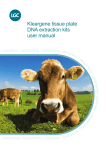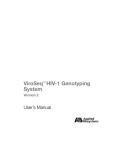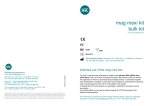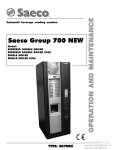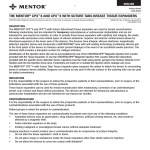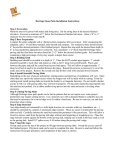Download Kleargene XL blood DNA extraction kit user manual
Transcript
Kleargene XL blood DNA extraction kit user manual • extraction • sequencing • genotyping • ex trac ti on •s eq ue nc in g •g eno typ ing • extr acti o n• s eq ue n c in g •g en o ty ping • extraction • sequencing • genotyping • Contents of this guide 1 Product description and specification 2 Kit contents 3 Reagent preparation 4 Safety information 5 10 mL whole blood extraction protocol 5.1 Cell lysis and binding of DNA to silica 5.2 1st washing stage 5.3 2nd washing stage 5.4 3rd washing stage 5.5 Ethanol washing stage 5.6 Elution 6Notes 7Troubleshooting 8 Data quality 9 Frequently asked questions 1. Product description and specification The Kleargene family are a series of kits designed to enable simple, rapid extraction and purification of genomic DNA from a variety of different sources. The Kleargene XL blood DNA kit is specifically designed for the extraction of DNA from large blood samples (1 mL to 10 mL volume). The buffer volumes are directly scalable depending on initial blood volume, meaning ten-fold more extractions can be done with the same kit if a ten-fold lower blood volume is used. The Kleargene method is based on the highly proven technology of detergent-driven cell lysis, followed by guanidinium isothiocyanate-mediated DNA binding DNA binding to silica. Contaminants are removed by washing and DNA is subsequently eluted into a low salt buffer. The entire process is carried out in one tube per sample, and is easy to perform. For any queries on this manual or running KASP reactions in your laboratory please contact: All locations except USA: Email: [email protected] • Phone: +44 (0)1992 476 486 USA only: Email: [email protected] • Phone: +1 978 338 5317 2 2. Kit contents Component Storage1 KBS-1012-400 KBS-1012-401 KBS-1012-442 Buffer B1 2 20-25°C 250 mL 1000 mL 5000 mL Buffer C1 20-25°C2 500 mL 2 x 1000 mL 2 x 5000 mL Buffer A1 (concentrate) 20-25°C 250 mL 2 x 500 mL 2 x 2500 mL Buffer W1 (concentrate) 20-25°C 75 mL 300 mL 1500 mL Buffer E1 20-25°C 30 mL 125 mL 1000 mL Blood kit - 8 32 160 Table 1: Contents of the Kleargene Blood XL DNA extraction kit. 1 2 – before the required additional reagents are added to each buffer – this should be stored in the dark To be supplied by the user Additional reagents • Ethanol • Isopropanol (propan-2-ol; 2-propanol) • β-mercaptoethanol (2-mercaptoethanol) or dithiothreitol (DTT). Equipment needed • Manual pipettes and disposable pipette tips • Large-volume centrifuge with appropriate rotors and buckets • Fan oven • Personal protective equipment (lab coat, gloves, goggles) • 50 mL reaction tubes. 50 mL reaction tubes can be ordered from LGC (part number KBS-1012-010). For any queries on this manual or running KASP reactions in your laboratory please contact: All locations except USA: Email: [email protected] • Phone: +44 (0)1992 476 486 USA only: Email: [email protected] • Phone: +1 978 338 5317 3 3. Reagent preparation • Precipitates can form in both buffer B1 and C1 after prolonged lowtemperature storage; incubate at 37°C if this is the case and mix well until clear. Please note: Buffer B1 contains silica in suspension, so do not confuse this with the formation of precipitates. • Ensure that the buffers are mixed well before use, following addition of the necessary reagents. Component Reagent to add 8x sample prep kit 32x sample prep kit 160x sample prep kit Buffer B1 β-mercaptoethanol 2 mL 8 mL 40 mL Buffer C1 β-mercaptoethanol 4 mL 2 x 8 mL 2 x 40 mL Isopropanol 125 mL 2 x 250 mL 2 x 1250 mL Ethanol 125 mL 2 x 250 mL 2 x 1250 mL Ethanol 175 mL 700 mL 3500 mL Buffer A1 Buffer W1 Table 2: Reagents to be added to buffers • The volumes of each reagent to be added are also declared on the labels of the bottles. Buffers B1 & C1 • oth require the addition of β-mercaptoethanol at a ratio of 0.8 mL of 100% B 2-mercaptoethanol per 100 mL of buffer. Alternatively, dithiothrietol (DTT) may be used at 100 mM final concentration. • It is recommended that any buffer to which β-mercaptoethanol or DTT is added should be used immediately, and that the buffers should be aliquoted appropriately before this addition is made if they are not to be used in its entirety. Buffer A1 • This buffer requires the addition of ethanol and isopropanol to a final concentration of 25% (v/v) each. Buffer W1 • This buffer requires the addition of ethanol to a final concentration of 70%. For any queries on this manual or running KASP reactions in your laboratory please contact: All locations except USA: Email: [email protected] • Phone: +44 (0)1992 476 486 USA only: Email: [email protected] • Phone: +1 978 338 5317 4 4. Safety information DO NOT ADD BLEACH OR ACIDIC SOLUTIONS DIRECTLY TO THE SAMPLE PREPARATION WASTE. • The sample preparation waste contains guanidinium isothiocyanate which can form highly reactive compounds when combined with bleach. If liquid containing these buffers is spilt, clean with suitable laboratory detergent and water. If the spilt liquid contains potentially infectious agents, clean the affected area first with laboratory detergent and water, and then with 1% (v/v) sodium hypochlorite. • It is highly recommended that personal protective equipment is worn throughout the extraction process. • For more detailed information, please refer to the safety data sheets (SDS). For any queries on this manual or running KASP reactions in your laboratory please contact: All locations except USA: Email: [email protected] • Phone: +44 (0)1992 476 486 USA only: Email: [email protected] • Phone: +1 978 338 5317 5 5. 10 mL whole blood extraction protocol The volumes of each buffer used in the protocol are directly scalable in proportion to the amount of starting material extracted. For example, extraction from 1 mL blood samples will require 3 mL of the buffers, extraction from 5 mL blood samples will require 15 mL of the buffers. For buffy coat samples, the original volume of blood from which the buffy coat was fractionated should be determined before deciding upon the appropriate volume of binding buffer to use. For example, if 1 mL buffy coat was derived from 10 mL whole blood, 30 mL binding buffer should be used. The protocol below is based on 10 mL starting material. 5.1 Cell lysis and binding of DNA to silica 1. Add 30 mL of buffer B1 into a 50 mL centrifuge tube, ensuring that the silica particles in the buffer are thoroughly re-suspended by vortexing prior to use. 2. Transfer 10 mL of blood from the collection tube into the 50 mL centrifuge tube containing the buffer B1 , and vortex the mixture until homogeneous. 3. Incubate at room temperature for a minimum of 5 minutes, then vortex the mixture. 4. Pellet the silica particles in the mixture by centrifugation at 3,000 x g for 2 minutes. Pour off the supernatant and discard this according to your laboratory waste procedures. 5.2 1st washing stage 5. Add 30 mL of buffer C1 to the centrifuge tube containing the silica pellet, and vortex thoroughly to re-suspend the pellet in the solution. 6. Pellet the silica particles in the mixture by centrifugation at 3,000 x g for 2 minutes. Pour off the supernatant and discard this according to your laboratory waste procedures. 7. Repeat steps 5 & 6 once. 5.3 2nd washing stage 8. Add 30 mL of buffer A1 to the centrifuge tube containing the silica pellet, and vortex thoroughly to re-suspend the pellet in the solution. 9. Pellet the silica particles in the mixture by centrifugation at 3,000 x g for 2 minutes. Pour off the supernatant and discard this according to your laboratory waste procedures. 10. Repeat steps 8 & 9 once. For any queries on this manual or running KASP reactions in your laboratory please contact: All locations except USA: Email: [email protected] • Phone: +44 (0)1992 476 486 USA only: Email: [email protected] • Phone: +1 978 338 5317 6 5.4 3rd washing stage 11. Add 30 mL of buffer W1 to the centrifuge tube containing the silica pellet, and vortex thoroughly to re-suspend the pellet in the solution. 12. Pellet the silica particles in the mixture by centrifugation at 3,000 x g for 2 minutes. Pour off the supernatant and discard this according to your laboratory waste procedures. 5.5 Ethanol washing stage 13. Add 30 mL of 100% ethanol to the centrifuge tube containing the silica pellet, and vortex thoroughly to re-suspend the pellet in the solution. 14. Pellet the silica particles in the mixture by centrifugation at 3,000 x g for 2 minutes, and then pour off the supernatant which can be discarded. 15. Invert the open tube for 5 minutes over tissue paper and then dry in a fan oven at 55°C for 30 minutes (or until the pellet appears completely dry and there is no residual smell of ethanol). 5.6Elution 16. Add an appropriate volume of buffer E1 (pre-warmed to 55°C), and vortex thoroughly to re-suspend the pellet in the solution. 17. Incubate the mixture in a fan oven at 55°C for 15 minutes, and vortex thoroughly to re-suspend the pellet in the solution. 18. Pellet the silica particles in the mixture by centrifugation at 3,000 x g for 5 minutes. Carefully aspirate off the DNA solution and pipette it into the destination tube / plate. For any queries on this manual or running KASP reactions in your laboratory please contact: All locations except USA: Email: [email protected] • Phone: +44 (0)1992 476 486 USA only: Email: [email protected] • Phone: +1 978 338 5317 7 6. Notes • A single elution typically yields 70 - 80% of the total DNA bound to the silica particles; a second elution step can be performed to remove almost all of the remaining DNA if maximal yield is required. This second elution step will inevitably cause the overall concentration of the eluted DNA to be reduced.The theoretical maximum yield is approximately 40 µg of DNA per mL of standard human blood. • DNA is not significantly fragmented by the method, with typical fragment sizes of >40 kb obtained. • The absence of nucleases in samples prepared with Kleargene has been demonstrated by overnight incubation at 37°C in the presence of 10 mM MgCl2. • The binding buffer contains silica particles; these settle at the bottom of the bottle over the course of a few minutes, so consequently it is very important to ensure that these are completely re-suspended by vortexing / shaking immediately prior to use. • When processing blood samples showing evidence of coagulation, the incubation period of protocol step three should be lengthened, interspersing the incubation with extra vortexing stages if necessary until the clots have fully dissolved. Similarly, the same approach should be used when processing lyophilised blood samples using the same procedure. • If necessary, the extraction process can be suspended at any step and the tubes can be kept for many hours at room temperature. Re-centrifugation to pellet the silica particles will, however, be necessary before resuming the protocol. In particular, the process may be halted after protocol step three for a number of days without affecting the quality of DNA obtained. • After any step in the protocol in which the silica particles are pelleted by centrifugation, it is advisable to decant the supernatant immediately; if there is any doubt about the length of time that has elapsed since centrifugation was performed, the tube should be centrifuged once more. • A 4°C refrigerated centrifuge is particularly useful for protocol step 18 as this will reduce the possibility of silica sloughing off the pellet when aspirating the eluate; failing this, immediate refrigeration after centrifugation, possibly followed by brief recentrifugation may help. For any queries on this manual or running KASP reactions in your laboratory please contact: All locations except USA: Email: [email protected] • Phone: +44 (0)1992 476 486 USA only: Email: [email protected] • Phone: +1 978 338 5317 8 7. Troubleshooting Problem Likely cause Explanation / suggestions Blood samples contain clots This is especially prevalent in lyophilised blood samples but can also be seen with incorrectly stored samples or blood stored for long periods. Clots can be dissolved with extended incubation in buffer B1 (binding buffer), and additional vortexing. Poor DNA yield Blood storage Ensure that blood samples are stored appropriately to minimise DNA degradation. It is recommended that all samples should be stored at -20°C or lower. Mixing of binding solution Buffer B1 contains silica particles; these settle at the bottom of the bottle over the course of a few minutes. It is very important to ensure that these are completely resuspended by vortexing / shaking immediately prior to use. Maintenance of pellet integrity After any step in the protocol in which the silica particles are pelleted by centrifugation, it is advisable to decant the supernatant immediately. If there is any doubt about the length of time that has elapsed since centrifugation, the tube should be centrifuged once more. Elution temperature Buffer E1 should be pre-warmed to 55°C prior to use. If this is not done, DNA yield will be reduced. Silica sloughing Centrifugation not performed at off from the silica sufficiently low temperature pellet during the elution step Ensure that the sample is centrifuged at 3,000 x g at a low temperature (4°C). DNA is degraded Poor sample storage prior to extraction Ensure that blood samples are stored appropriately to minimise DNA degradation. It is recommended that all samples should be stored at -20°C or lower. Eluted DNA has a red colour Wash steps insufficient to completely remove red colour. In exceptional cases, the eluted DNA may retain a faint red colour. For other samples of the same type, an additional wash step with buffer C1 can be included (i.e. a total of three washes with buffer C1 in sequence). If absolutely necessary, the affected eluted DNA samples can be put through the extraction procedure again to remove any traces of redness, though this should not be necessary. DNA does not perform well in downstream experiments Ethanol carryover Ensure that the pellet is completely dry after the final wash step with ethanol. Salt carryover Ensure that the wash buffers (A1 and W1 are at room temperature before use. Insufficient / excessive DNA used in downstream experiments. Optimise the quantity of DNA that is used in downstream experiments with a DNA dilution series. Too much or too little DNA can adversely affect experimental performance. For any queries on this manual or running KASP reactions in your laboratory please contact: All locations except USA: Email: [email protected] • Phone: +44 (0)1992 476 486 USA only: Email: [email protected] • Phone: +1 978 338 5317 ) 9 8. Data quality Below left is an example of the DNA quality that can be expected when using the Kleargene XL blood kit. Below right is an example of the expected quality of genotyping data that can be obtained when using DNA samples extracted with the Kleargene XL blood kit. Spectral analysis of DNA extracted using the Kleargene XL blood kit SNP genotyping cluster plot generated by use of the KASP chemistry with Kleargene-purified DNA For any queries on this manual or running KASP reactions in your laboratory please contact: All locations except USA: Email: [email protected] • Phone: +44 (0)1992 476 486 USA only: Email: [email protected] • Phone: +1 978 338 5317 10 8. Frequently asked questions 1. What type of centrifuge is required for the Kleargene plant tissue protocol? The centrifuge will need an adapter suitable for plates, and to be capable of achieving 3000 x g. 2. Can the Kleargene buffers be purchased individually? Yes. All buffers can be purchased individually. Buffer Volume Product code B1 500 mL KBS-1012-312 C1 500 mL KBS-1012-308 A1 250 mL KBS-1012-309 W1 75 mL KBS-1012-310 E1 250 mL KBS-1012-311 Additional filter plates can also be purchased Plate size Pack size Product code 96-well 10 plates KBS-1012-303 3. Can the Kleargene kit be used for the extraction of RNA from plant tissue? No. If you are working with large numbers of samples, why not consider our Genespin™ platform. The Genespin enables semi-automated, high-throughput DNA extractions from plant tissues and utilises Kleargene chemistry. For any queries about this guide please contact: All locations except USA: email [email protected] or call +44 (0)1992 476 486 USA only: email [email protected] or call +1 978 338 5317 www.lgcgroup.com/genomics • [email protected] Science for a safer world Brazil • Bulgaria • China • Czech Republic • Finland • France • Germany • Hungary • India • Ireland • Italy • Netherlands Poland • Romania • Russia • South Africa • Spain • Sweden • Turkey • United Kingdom • USA All trademarks and registered trademarks mentioned herein are the property of their respective owners. All other trademarks and registered trademarks are the property of LGC and its subsidiaries. Specifications, terms and pricing are subject to change. Not all products are available in all countries. Please consult your local sales representative for details. No part of this publication may be reproduced or transmitted in any form or by any means, electronic or mechanical, including photocopying, recording or any retrieval system, without the written permission of the copyright holder. © LGC Limited, 2014. All rights reserved. 4046/CF/0714












